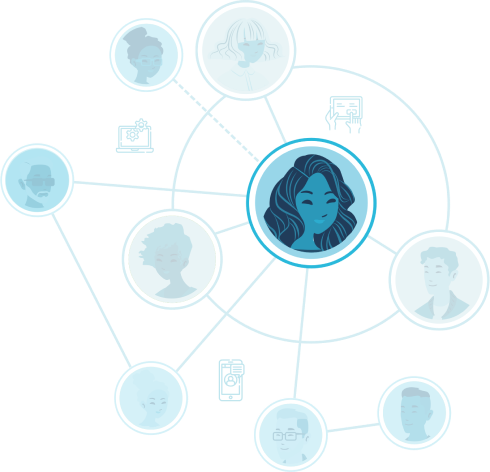Step 4. Leverage Edtech that Connects: Bringing New Relationships Within Reach for Students


Guiding questions:
-
How is your school or organization currently using technology to foster connections? Do any of your existing tools have social features and functionalities that you’re not putting to use?
-
What types of relationships are currently “out of reach”—because of time, cost, or geographic distance—for your students that edtech could help leverage?
-
How are both your organization and your individual students currently keeping track of the relationships being forged?

Without the data—and the tools to collect and analyze the data—how can we measure the impact of expanded networks for our students?”
KATE SCHRAUTH, EXECUTIVE DIRECTOR, ICOULDBE
A powerful supply of technology-enabled tools that can expand and diversify students’ networks is increasingly within reach. Paired with integrated supports, these innovative technologies can be game-changing for schools, particularly those serving students from under-resourced communities. Systems leveraging technology to connect their students to relationships beyond their reach should measure:
- The number and type of new relationships forged through the edtech tools
- Students’ ability to document and track the growth of these relationships
- Students’ access and ability to re-engage with the individuals they connect with through technology
-
1
Technology has a competitive advantage when it comes to diversifying weak ties.
Technology can be seen as an underwhelming surrogate for strong, caring, in-person connections. But it can be an efficient tool for finding, forging, and storing weak ties that still offer new information and opportunities.
-
2
Technology can address gaps in access.
In some cases, technology-enabled connections are better than no connections at all. Technologies can target areas where relationships are out of reach and students lack access to connections—such as those to professionals working beyond students’ home towns or to near peers navigating college and careers beyond students’ schools.
-
3
Multimodal online connections made possible through technology platforms can increase empathy and authenticity.
It is easier to form and express empathy over a video chat—where you can experience both visual and audio cues—than over a phone or text chat.
Note: Open the PDF to see a complete list of research citations.

We created an app because we simply couldn’t afford not to. We believe that a high-tech, high-touch solution is the key to achieving social impact at scale.”
ALEXANDRA BERNADOTTE, FOUNDER AND CEO, BEYOND 12
Today, we can use technology to connect at the press of a button. But for many programs, poor experiences before and during the pandemic may make them especially wary of trying to forge and maintain relationships in online environments. Technology should support your relationship strategy—it can’t be the strategy itself. In that spirit, the following approaches can play to technologies’ advantages in helping schools and programs organize and broker both virtual and in-person connections, without sacrificing privacy and quality.
Click on the green text to see more.
If you’re working to ensure safety and privacy first → Follow background check guidelines and ensure tools are designed to protect personally identifiable information:
Edtech tools follow different safety protocols depending on the student populations they are designed to serve. For schools and programs serving younger students, some programs adopt a one-to-many policy, meaning students are only interacting online in groups, often under the supervision of an educator. Others make sure that any tools that allow for one-on-one interaction also apply web filters that can monitor the content of student-adult interactions and flag any potentially inappropriate content. These filters catch risky behaviors such as sharing locations or personal information that could threaten student privacy or safety. Some tools have gone even further to protect students’ identities. For example, iCouldBe, an online mentoring platform, has used avatars instead of photos to protect student privacy. As filtering technologies improve, more programs will likely move to video-based interactions and chats that can be properly filtered.
If you’re just starting to use technology to forge connections → Target connections otherwise out of reach:
Most programs will tend to compare the quality of in-person connections to virtual ones—and find themselves underwhelmed with virtual connections. But technologies that expand students’ networks will be best-suited to circumstances where relationships are out of reach. These could include relationships in your local community that are difficult to integrate into day-to-day programming, or individuals who live and work in other geographies. While these connections might not be as strong as traditional, face-to-face relationships, they will still be able to foster new relationships and diverse networks, and can make up for roles that are hard to access in person.
If you’re aiming to build affinity groups among and on behalf of students → Explore technologies designed to expand access to individuals who share students’ identities and interests:
Given that similarity breeds trust, connecting students with people from similar backgrounds can begin building a foundation for that trust. This strategy is especially powerful if you’re trying to broker connections for students of color or students with other marginalized identities to people with shared backgrounds and identities. Some technology platforms, like DreamWakers and Mentor Spaces, have been designed to specifically put new, affinity-based connections within reach.
If you’re trying to connect students' local resources more efficiently→ Consider tools that organize local connections beyond spreadsheets or directories:
Sometimes relationships are “out of reach” not because of distance, but because of time and coordination costs. For those connections, look for technologies that can be used to organize local resources. These can offer efficiencies in sorting, filtering, and scheduling to integrate community members, employers, and alumni into coursework, student support, or career guidance, while providing teachers and faculty with choices to align to their lesson plans and syllabi. A number of emerging technologies offer the capability to both coordinate virtual and in-person connections. By engaging in the “taking stock” strategies in Step 1, you can populate online tools with local, existing relationships in students’ existing networks and provide a mix of both online and offline connections.
If you’re offering experiential, project-based learning → Integrate virtual experts to offer inspiration, project examples, and feedback:
As educators weave real-world learning into their classrooms, they can scale access to real-world relationships too. Integrating virtual experts at the front end of lessons can spark engagement by making project work more relevant for students. Integrating virtual experts during projects to advise students or offer real-world feedback can help students build both the relationships and skills needed to secure jobs down the line.
-

Cajon Valley Union School District’s “Meet-a-Pro” model uses technology to bring local and global professional connections into the classroom.
Cajon Valley Union School District is a public school district that provides K–12 students with career-related learning. Guided by its World of Work curriculum, students have numerous opportunities to Meet-a-Pro, in which students engage in virtual tours, field trips, and industry chats with working professionals. To scale Meet-a-Pro, the school district uses a tool called Nepris, which ports virtual volunteer industry experts working around the world into classrooms. But Cajon Valley also taps networks in its own backyard. The District has populated Nepris with local connections, including both district employees that work in its central offices and family networks across the district. For more on the Cajon Valley approach, check out our Cajon Valley case study.
Evidence of impact
54% of middle school students reported gaining confidence in their abilities for a future job if they “personally know someone who has done this job.”
Sample data collection strategy
Cajon Valley tracks the number and type of industry professionals students are exposed to through the Nepris platform. K–8 students collectively experienced 69,000 views of live industry chats or Meet-a-Pro experiences via Nepris in just over two years.
-

iCouldBe fosters secure online connections that, in turn, help students expand their offline networks.
iCouldBe brings online mentors from all career backgrounds into high school classrooms where 50-100% of students live at or below the poverty line. The platform is deeply focused on secure, virtual interactions. Mentees and mentors can share information to build a relationship, but can’t share personally identifiable information—any information that would allow mentees and mentors to connect physically or virtually outside of the program where no supervision is possible. To overcome the inability of mentees to share photographs, Instagram pages, etc., functionality on the site allows mentors and mentees to create custom avatars and participate with their mentor one-on-one in curricular activities that become highly personalized based on each mentee’s unique personal, academic, and career interests, and post-secondary goals. iCouldBe is enhancing its “connections map” component on its platform where students can visualize their networks on an ongoing basis. (Notably, the students iCouldBe serves prefer the term “connections” to “networks”). While completing the online quests, the map is automatically populated as students identify real-world connections to strengthen, such as those with teachers, coaches, and counselors, and develop new connections with people they would like to meet. Students are asked to fill out a form identifying what types of support these connections can offer and how frequently they connect with these individuals. The connections map will have multiple filters that allow students to see connections with shared career interests and different ways they know people (for example through iCouldBe, family, school, community, internships, etc.). Read more here.
Evidence of impact
63% of mentees reported that prior to the program they had natural mentors (in their offline lives). After the program, that percentage grew to 81%.
Sample data collection strategy
iCouldBe offers students a series of activities called “quests” that prompt students to identify and forge connections based on interests; students add these connections to their online network maps using the iCouldBe app.
How are you currently leveraging technology to help students foster or maintain relationships? What additional relationships that are hard-to-find could you forge using technology tools? Create a plan to leverage edtech that connects.
Download our guided worksheet to keep track of your progress while going through the playbook.
Customize a plan-
The Christensen Institute’s Edtech that Connects directory
This directory catalogues a number of tools that the Christensen Institute has been tracking that offer virtual connections or platforms you can use to organize your own local ecosystem of relationships.
-
MENTOR’s Supplement to the Elements of Effective Practice for Mentoring
This resource offers guidance for translating effective mentoring practices into virtual environments. Pages 17-19 include descriptions of programs and researchers that are e-mentoring experts. Pages 26-39 include recommendations to support e-mentoring programs.
-
"Who You Know" book chapter, "EdTech That Connects"
This book chapter analyzes new, affordable technologies that can foster connections beyond students' inherited networks, and describes the long-term potential of this sector of the edtech market.
